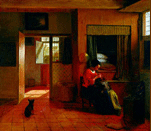2.
Creative Women:
Fashioning an Identity and Community
Organizers:
- Erith Jaffe-Berg, Theater, The Hebrew University, Israel
- Anne R. Larsen, French, Hope College
- Marjorie Och (organizer), Art History, Mary Washington College
- Amy Scott-Douglass, English, California State University at Fullerton
Description:
This workshop explores the primary texts, both literary and visual, through
which creative women sought to build community amongst themselves and an audience
for their work. Through distributed readings and images (theatrical productions,
dialogues, poetry, prefaces, portrait medals), we invite participants to explore
the commonalities among creative women in early modern Europe, and how these
commonalities fostered identity and community. Each convener offers selected
readings, a brief statement on the readings, and a question aimed to open
discussion in the workshop (see paragraphs below). We ask participants to
come to the workshop with responses to at least two questions after reflecting
on how the materials illuminate their own research and teaching.
We will open with a general statement on the organization of the workshop
in which the activities of the workshop will be outlined. This will be followed
by introductions of conveners and participants, offering everyone an opportunity
to introduce themselves and their interests in the workshop (about 10 minutes).
Following the introductions, each convener will take approximately five minutes
to state what she feels is most critical for a discussion of creative women's
community/ies as related to the readings (20 minutes total). We will then
offer participants the opportunity to break into smaller groups. Conveners
will each take a group individually or in pairs, depending on number of participants.
This small group activity will allow participants to focus specifically on
readings assigned by the convener(s) leading that group; in order to weave
our smaller groups together, each group will spend some time considering how
their small-group readings relate to questions raised by one of the other
conveners/small groups. We will take about 20 minutes for this group work.
The larger group will then reunite for 30 minutes to share ideas and issues
raised within the smaller groups. One aim at this point will be to find commonalities
among our different disciplinary approaches; we may also devote time here
to methodologies for teaching these materials. The final 10 minutes will be
reserved for summaries and concluding observations by the four conveners.
The material examined here allows for an investigation into the meaning of
both identity and community for early modern readers and viewers, as well
as for twentyfirst-century scholars. Did women see their productions as creating
community for themselves distinct from or within the community of male humanists,
writers, and artists? Questions we raise offer new ways of thinking about
how a gendered group identity could be defined for an early modern audience
through literary and visual sources.
Our interest in how creative women fashioned a sense of self and community
that was effectively communicated across linguistic and political borders
leads directly to discussion and understanding of women's subjectivities in
the early modern period. Moreover, since the women under discussion fashioned
their identities and communities both within and against predominantly male
paradigms, our workshop includes issues of teaching and revising the canon
within and across our disciplines.
Suggested readings:
- Clubb, Louise George. "The Law of Writ and Liberty: Italian Professional
Theatre. In Italian Drama in Shakespeare's Time. New Haven: Yale University
Press, 1989. pp. 249-280. (Jaffe-Berg)
- Piéjus, Marie-Françoise. "La création au feminin
dans le discours de quelques poétesses du XVIe siècle."
In Dire la création. La culture italienne entre poétique et
poétique, edited by D. Budor, pp. 79-90. [Lille:] Presses universitaires
de Lille, 1994. (Larsen) de Romieu, Marie. "A Brief Discourse: That
Woman's Excellence Surpasses That of Man." In Writings by Pre-Revolutionary
French Women. From Marie de France to Elisabeth Vigée-Le Brun, edited
by Anne Larsen and Colette Winn, translated by Marian Rothstein, pp. 137-149.
New York: Garland Pub., 2000.
- (Larsen) Russell, Rinaldina, ed. Italian Women Writers. A Bio-Bibliographical
Source Book. Westport, Conn.: Greenwood Press, 1994; articles on O. Morata
and L. Terracina.
- (Larsen) Saslow, James M. The Medici Wedding of 1589: Florentine Festival
as Theatrum Mundi. New Haven: Yale University Press, 1996; especially the
introduction. (Jaffe-Berg) Scher, Stephen K., et al. The Currency of Fame:
Portrait Medals of the Renaissance. New York: Harry N. Abrams, Inc., 1994.
- (Och) Scott-Douglass, Amy. "Self-Crowned Laureatess: Towards a Critical
Revaluation of Margaret Cavendish's Prefaces." Pretexts: Literary and
Cultural Studies 9/1 (2000): 27-49.
- (Larsen) Sigée, Louise. Dialogue de deux jeunes filles sur la vie
de cour et la vie de retraite (1552), edited by Odette Sauvage. Paris: Presses
universitaires, 1970.
- (Larsen) Syson, Luke. "Consorts, Mistresses and Exemplary Women:
The Female Medallic Portrait in Fifteenth-Century Italy." In The Sculpted
Object, 1400-1700, edited by Stuart Currie and Peta Motture, pp. 43-64.
Brookfield, VT: Scolar Press/Ashgate, 1997.
- (Och) Tylus, Jane. "Women at the Windows: Commedia dell'Arte and
Theatrical Practice in Early Modern Italy." Theatre Journal 49 (1997):
323-342. (Jaffe-Berg)
Preliminary statements and questions offered by conveners:
Jaffe-Berg's readings provide background for the commedia dell'arte performance
of "The Madness of Isabella" staged for the 1589 wedding celebrations
of Ferdinando de' Medici and Christine of Lorraine. The events were orchestrated
by a self-conscious Medici ruler intent on projecting his policy within a
lavish and costly series of representations. At the same time, Isabella Andreini,
a leading commedia dell'arte actress, used the performance as a platform through
which to create a female space by employing French within the performance,
thus directing her attention to the bride. Jaffe-Berg will ask participants
to consider to what extent internationalism and multilingualism, implicit
in Andreini's work, is a component of her self-making strategy and important
to her forging of an extended community and audience for her work.
Andreini, Isabella. "The Madness of Isabella," in
Flaminio Scala, Il Teatro delle favole rappresentative (1611) trans. by Henry
F. Salerno in Scenarios of the Commedia dell'Arte. New York: Limelight Editions,
1996. (2 pp.)
McGill, Kathleen. "Women and Performance: The Development of Improvisation
by the Sixteenth-Century Commedia dell'Arte." Theatre Journal 43/1 (March
1991): 59-61.
Larsen's readings explore Catherine des Roches's ideas about
women's need to forge their own identity through learning. In des Roches's
"Dialogue between Placide and Severe" from Les Secondes Oeuvres
(1583), the author includes a catalogue of contemporary scholarly women. Rather
than a more conventional list of women from antiquity and the Christian past,
des Roches cites "famous contemporary women" such as Luisa Sigea,
Cassandra Fedele, Laura Terracina, Olympia Morata, and Ippolita Torelli, to
which are added the second century Proba Falconia, the legendary Clemence
Isaure, and Diane de Morel, daughter of the Parisian humanist Jean de Morel.
Why did des Roches select these women as exemplars? Why the emphasis on Italian
women?
des Roches, Catherine. "Dialogue Between Placide and Severe,"
in Les Secondes Oeuvres (1583), ed. A. Larsen (Geneva, 1999). (3 1/2 pp.)
Terracina, Laura Baccio, in Women Poets of the Italian Renaissance, edited
by Laura A. Stortoni, (New York, 1997), pp. 109, 111-13.
Och's readings examine sixteenth-century portrait medals of
women, specifically Vittoria Colonna, poet, and Lavinia Fontana, painter.
Earlier medals depict the artist, humanist or prince in his classicizing setting
and garb. It was into this largely male domain that women made an appearance.
As objects which stood in for a woman's actual presence, medals were vehicles
for the fashioning of a community and audience, both male and female, for
creative women. Scholars have been reluctant to credit women with the commission
or design of their medals. Workshop participants will be asked to consider
the portrait medal as evidence of ways creative women chose to present themselves
to their various audiences, and how women's agency in the production of portrait
medals might be considered.
Och, Marjorie. "Portrait Medals of Vittoria Colonna: Representing
the Learned Woman." In Women as Sites of Culture: Women's Roles in Cultural
Formation from the Renaissance to the Twentieth Century, edited by Susan Shifrin,
pp. 153-63. Aldershot: Ashgate, 2002. (focus on pp. 158-61)
Schaefer, Jean Owens. "A Note on the Iconography of a Medal of Lavinia
Fontana." Journal of the Warburg and Courtauld Institutes 47 (1984):
232-34.
Scott-Douglass's readings focus on selected prefaces to texts
by Margaret Cavendish and Jane Lead. Although their lives were very different
(Lead was a radical Puritan and mystic, and Cavendish was an aristocrat and
natural philosopher) their prefatory rhetoric is remarkably similar: both
of these seventeenth-century English writers represent themselves as women
laureates, poet-prophet-philosophers; both claim to have a distinguished relationship
to knowledge, personified in Cavendish's case as Nature and in Lead's case
as the Virgin Wisdom; and both wrote for posterity's sake and had their texts
translated and distributed on the Continent. Scott-Douglass will ask the group
to consider these prefaces as responses to what is usually a male discourse.
Cavendish, Margaret. Prefatory materials to Philosophical and
Physical Opinions (1655), especially "To the Reader" [the first
preface], "To the Two Universities," and the frontispiece. (2 pp.)
Lead, Jane. Prefaces to The Laws of Paradise (1695), http://www.passtheword.org/Jane-Lead/.
Especially "The Preface" and "The Motto." (1/2 p.)
Lead, Jane. Prefaces to Fountain of Gardens, vol. 2 (1697), especially "The
Epistle of the Author" and "The Editor to the Reader." (2 pp.)





















